Securing a Child Restraint Designed for the LATCH System
![]() WARNING
WARNING
If a LATCH-type child restraint is not attached to anchors, the child restraint will not be able to protect the child correctly. In a crash, the child could be seriously injured or killed. Install a LATCH-type child restraint properly using the anchors, or use the vehicle safety belts to secure the restraint, following the instructions that came with the child restraint and the instructions in this manual.
![]() WARNING
WARNING
Do not attach more than one child restraint to a single anchor. Attaching more than one child restraint to a single anchor could cause the anchor or attachment to come loose or even break during a crash. A child or others could be injured. To reduce the risk of serious or fatal injuries during a crash, attach only one child restraint per anchor.
![]() WARNING
WARNING
Children can be seriously injured or strangled if a shoulder belt is wrapped around their neck and the safety belt continues to tighten. Buckle any unused safety belts behind the child restraint so children cannot reach them.
Pull the shoulder belt all the way out of the retractor to set the lock, if the vehicle has one, after the child restraint has been installed.
![]() Notice: Do not let the LATCH attachments rub against the vehicle’s safety belts.
This may damage these parts. If necessary, move buckled safety belts to avoid rubbing
the LATCH attachments.
Notice: Do not let the LATCH attachments rub against the vehicle’s safety belts.
This may damage these parts. If necessary, move buckled safety belts to avoid rubbing
the LATCH attachments.
Do not fold the empty rear seat with a safety belt buckled. This could damage the safety belt or the seat. Unbuckle and return the safety belt to its stowed position, before folding the seat. If you need to secure more than one child restraint in the rear seat, see Where to Put the Restraint .
This system is designed to make installation of child restraints easier. When using lower anchors, do not use the vehicle's safety belts. Instead use the vehicle's anchors and child restraint attachments to secure the restraints. Some restraints also use another vehicle anchor to secure a top tether.
1. Attach and tighten the lower attachments to the lower anchors. If the child restraint does not have lower attachments or the desired seating position does not have lower anchors, secure the child restraint with the top tether and the safety belts. Refer to the child restraint manufacturer instructions and the instructions in this manual.
1.1. Find the lower anchors for the desired rear outboard seating position.
1.2. Put the child restraint on the seat.
For outboard rear seating positions, if the head restraint interferes with the proper installation of the child restraint, the head restraint may be removed. See “Head Restraint Removal and Reinstallation” at the end of this section.
1.3. Attach and tighten the lower attachments on the child restraint to the lower anchors.
2. If the child restraint manufacturer recommends that the top tether be attached, attach and tighten the top tether to the top tether anchor, if equipped. Refer to the child restraint instructions and the following steps:
2.1. Find the top tether anchor. Open the top tether anchor cover to expose the anchor.
2.2. Route, attach, and tighten the top tether according to the child restraint instructions and the following instructions:
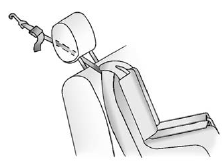
. If you are using a single tether in a rear outboard seating position with an adjustable head restraint, raise the head restraint and route the single tether under the head restraint and in between the head restraint posts.
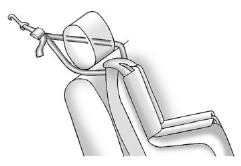
. If you are using a dual tether in a rear outboard seating position with an adjustable head restraint, raise the head restraint and route the tether under the head restraint and around the head restraint posts.
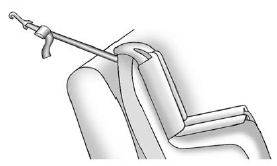
. If you are using a single tether in a rear outboard seating position and the head restraint has been removed, route the single tether over the seatback.
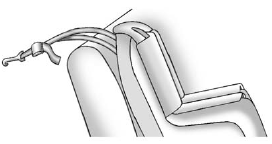
. If you are using a dual tether in a rear outboard seating position and the head restraint has been removed, route the dual tether over the seatback.
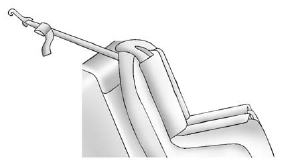
. If you are using a single tether in the rear center seating position, route the single tether over the headrest.
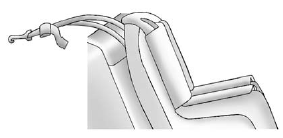
. If you are using a dual tether in the rear center seating position, route the dual tether over the headrest.
3. Before placing a child in the child restraint, make sure it is securely held in place. To check, grasp the child restraint at the LATCH path and attempt to move it side to side and back-and-forth. There should be no more than 2.5 cm (1 in) of movement, for proper installation.
See also:
Passenger Safety Belt Reminder Light
When the vehicle is started, this light flashes and a chime may come on to remind
front passengers to fasten their safety belt. Then the light stays on solid until
the belt is buckled.
For more ...
Fuel Gauge
When the ignition is on, the fuel gauge tells you about how much fuel you have
left in your tank.
An arrow on the fuel gauge indicates the side of the vehicle the fuel door is
on.
When the fue ...
XM Satellite Radio Service
XM is a satellite radio service based in the 48 contiguous United States and
10 Canadian provinces. XM satellite radio has a wide variety of programming and
commercial-free music, coast to coast, ...


